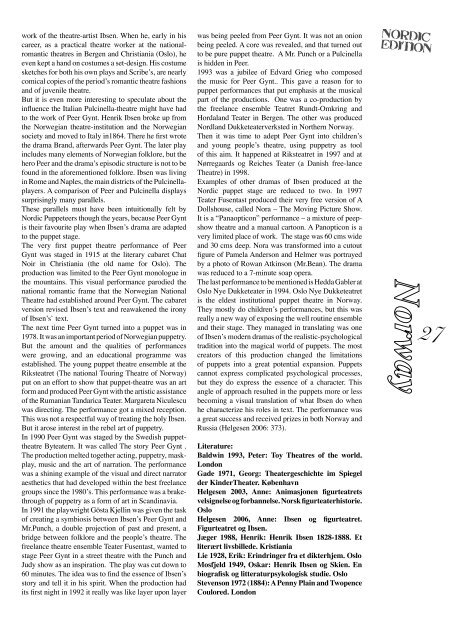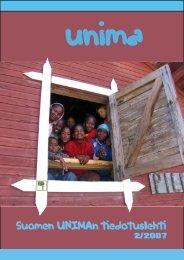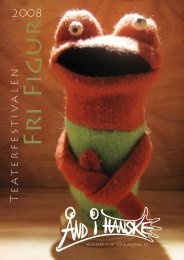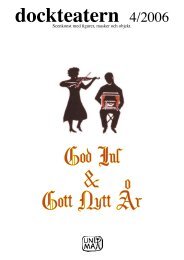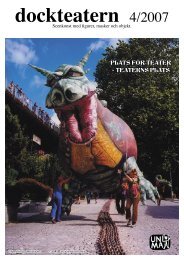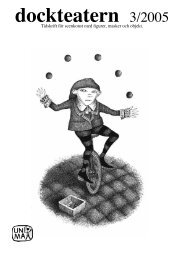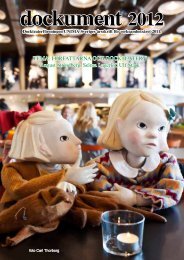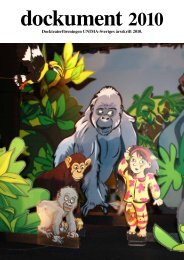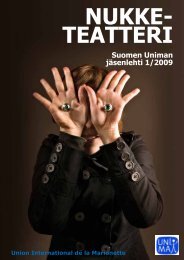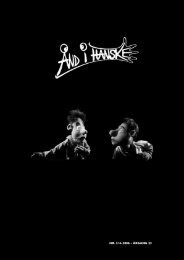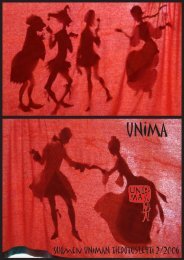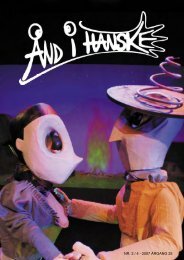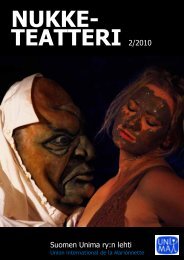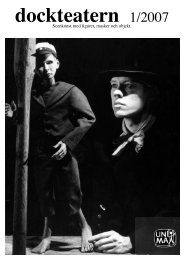Create successful ePaper yourself
Turn your PDF publications into a flip-book with our unique Google optimized e-Paper software.
work of the theatre-artist Ibsen. When he, early in hiscareer, as a practical theatre worker at the nationalromantictheatres in Bergen and Christiania (Oslo), heeven kept a hand on costumes a set-design. His costumesketches for both his own plays and Scribe’s, are nearlycomical copies of the period’s romantic theatre fashionsand of juvenile theatre.But it is even more interesting to speculate about theinfluence the Italian Pulcinella-theatre might have hadto the work of Peer Gynt. Henrik Ibsen broke up fromthe Norwegian theatre-institution and the Norwegiansociety and moved to Italy in1864. There he first wrotethe drama Brand, afterwards Peer Gynt. The later playincludes many elements of Norwegian folklore, but thehero Peer and the drama’s episodic structure is not to befound in the aforementioned folklore. Ibsen was livingin Rome and Naples, the main districts of the Pulcinellaplayers.A comparison of Peer and Pulcinella displayssurprisingly many parallels.These parallels must have been intuitionally felt by<strong>Nordic</strong> Puppeteers though the years, because Peer Gyntis their favourite play when Ibsen’s drama are adaptedto the puppet stage.The very first puppet theatre performance of PeerGynt was staged in 1915 at the literary cabaret ChatNoir in Christiania (the old name for Oslo). Theproduction was limited to the Peer Gynt monologue inthe mountains. This visual performance parodied thenational romantic frame that the Norwegian NationalTheatre had established around Peer Gynt. The cabaretversion revised Ibsen’s text and reawakened the ironyof Ibsen’s` text.The next time Peer Gynt turned into a puppet was in1978. It was an important period of Norwegian puppetry.But the amount and the qualities of performanceswere growing, and an educational programme wasestablished. The young puppet theatre ensemble at theRiksteatret (The national Touring Theatre of Norway)put on an effort to show that puppet-theatre was an artform and produced Peer Gynt with the artistic assistanceof the Rumanian Tandarica Teater. Margareta Niculescuwas directing. The performance got a mixed reception.This was not a respectful way of treating the holy Ibsen.But it arose interest in the rebel art of puppetry.In 1990 Peer Gynt was staged by the Swedish puppettheatreByteatern. It was called The story Peer Gynt .The production melted together acting, puppetry, maskplay,music and the art of narration. The performancewas a shining example of the visual and direct narratoraesthetics that had developed within the best freelancegroups since the 1980’s. This performance was a brakethroughof puppetry as a form of art in Scandinavia.In 1991 the playwright Gösta Kjellin was given the taskof creating a symbiosis between Ibsen’s Peer Gynt andMr.Punch, a double projection of past and present, abridge between folklore and the people’s theatre. Thefreelance theatre ensemble Teater Fusentast, wanted tostage Peer Gynt in a street theatre with the Punch andJudy show as an inspiration. The play was cut down to60 minutes. The idea was to find the essence of Ibsen’sstory and tell it in his spirit. When the production hadits first night in 1992 it really was like layer upon layerwas being peeled from Peer Gynt. It was not an onionbeing peeled. A core was revealed, and that turned outto be pure puppet theatre. A Mr. Punch or a Pulcinellais hidden in Peer.1993 was a jubilee of Edvard Grieg who composedthe music for Peer Gynt.. This gave a reason for topuppet performances that put emphasis at the musicalpart of the productions. One was a co-production bythe freelance ensemble Teatret Rundt-Omkring andHordaland Teater in Bergen. The other was producedNordland Dukketeaterverksted in Northern Norway.Then it was time to adept Peer Gynt into children’sand young people’s theatre, using puppetry as toolof this aim. It happened at Riksteatret in 1997 and atNørregaards og Reiches Teater (a Danish free-lanceTheatre) in 1998.Examples of other dramas of Ibsen produced at the<strong>Nordic</strong> puppet stage are reduced to two. In 1997Teater Fusentast produced their very free version of ADollshouse, called Nora – The Moving Picture Show.It is a “Panaopticon” performance – a mixture of peepshowtheatre and a manual cartoon. A Panopticon is avery limited place of work. The stage was 60 cms wideand 30 cms deep. Nora was transformed into a cutoutfigure of Pamela Anderson and Helmer was portrayedby a photo of Rowan Atkinson (Mr.Bean). The dramawas reduced to a 7-minute soap opera.The last performance to be mentioned is Hedda Gabler atOslo Nye Dukketeater in 1994. Oslo Nye Dukketeatretis the eldest institutional puppet theatre in Norway.They mostly do children’s performances, but this wasreally a new way of exposing the well routine ensembleand their stage. They managed in translating was oneof Ibsen’s modern dramas of the realistic-psychologicaltradition into the magical world of puppets. The mostcreators of this production changed the limitationsof puppets into a great potential expansion. Puppetscannot express complicated psychological processes,but they do express the essence of a character. Thisangle of approach resulted in the puppets more or lessbecoming a visual translation of what Ibsen do whenhe characterize his roles in text. The performance wasa great success and received prizes in both Norway andRussia (Helgesen 2006: 373).Literature:Baldwin 1993, Peter: Toy Theatres of the world.LondonGade 1971, Georg: Theatergeschichte im Spiegelder KinderTheater. KøbenhavnHelgesen 2003, Anne: Animasjonen figurteatretsvelsignelse og forbannelse. Norsk figurteaterhistorie.OsloHelgesen 2006, Anne: Ibsen og figurteatret.Figurteatret og Ibsen.Jæger 1988, Henrik: Henrik Ibsen 1828-1888. Etliterært livsbillede. KristianiaLie 1928, Erik: Erindringer fra et dikterhjem. OsloMosfjeld 1949, Oskar: Henrik Ibsen og Skien. Enbiografisk og litteraturpsykologisk studie. OsloStevenson 1972 (1884): A Penny Plain and TwopenceCoulored. London27


